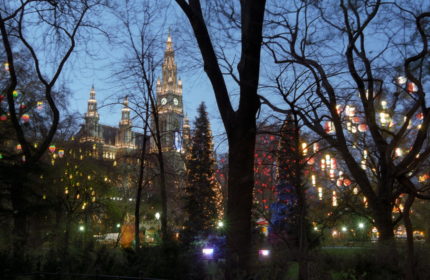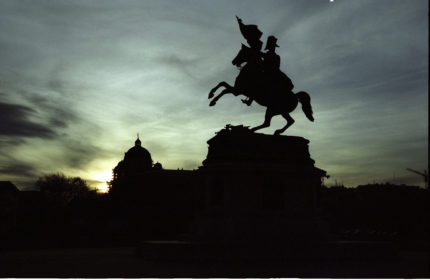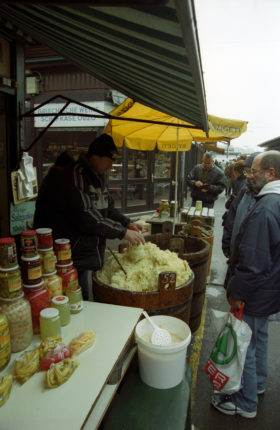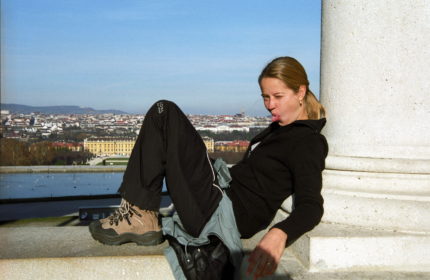
Christmas in Vienna
We arrived in Vienna on Saturday afternoon early, and our first task was to find a place to sleep for the night. A task which proved almst Herculean. We had planned on staying in the campground outside the city for the duration of our stay here, but because of Stephane’s knee injury, we decided that it would be better to stay closer to the center and to rest his knee as much as possible. So we decided on a youth hostel. We tried every single one in the city. Two had signs o the door saying “Off Duty. Please call —-.” So we took the phone numbers and called. No answer. We waited longer – still no answer. We could hear noise inside the reception of one hostel, which stopped immediately when we knocked on the door. The lights went out. Finally we found someone who directed us to a cafe, where they called one owner who informed us that the hostel was closed for the winter. Then why not put a sign indicating as much on the door? Why say “Off Duty”?
We spent a couple of hours trying to contact these two hostels before we finally gave up and tried the larger hostels, only to find out that they had already given all of the beds away. Saturday in Vienna. Bad day to arrive. Our guide book warned that Vienna is “a nightmare for budget travellers.” They could not have been more right. We decided we’d go to that campground out in the suburbs after all. We called first, thankfully. A recorded voice told us that the reception was only open between 8AM and 1PM. Now what? It was already dark and getting late. We had already spent five hours searching for a bed. I met two Korean girls in the last hostel who were in the same situation as us. We decided to head off together to look for something. They found a guest house across the street from the hostel and there was room for four. 15 euros per person. Cheaper than some of the hostels. We quickly took the room. It was dirty, and the smell emanating from the bathroom made us feel nauteous, but we hadn’t inspected the bathroom before paying. Besides, we would have taken almost anything at that point. It was only for one night. We could change tomorrow.
We did change the next day. To the hostel across the street, which had more room on Sundays. It was cheaper, and much cleaner.
Vienna is a city which is bound to impress anyone interested in architecture. It was the imperal seat of the Habsburg Dynasty, which ruled Austria for over 600 years, until Charles I abdicated in 1918 after the First World War and the Republic of Austria was founded. As a result, a lot of magnificent buildings were constructed hereover the centuries. The Hofburg Imperial Palace and Residence, the Treasury, Schonbrunn Palace, the Parliament building. Rococco and Gothic churches and palaces. Monumental museums. However, although the city’s impressive buildings are filled to over-flowing with culture and heritage, the city seemed rather cold to us. Not as personal as some of the cities we’ve been to. Even Paris, which is bigger, seems more personal with its small neighborhoods and narrow winding streets. Although we thoght Vienna had beautiful monuments, it did not charm us.

Vienna, Austria
That said, we’ve thoroughly enjoyed what Vienna has to offer in terms of music. Still known as the classical music capital of the world, we’ve tried to take advantage of our time here to immerse ourselves as much as possible in that music. We’ve been to see Verdi’s tragic opera “La Traviata” and Mozart’s comic opera “The Marriage of Figaro” at the State Opera House. Opera in Vienna is accessible to anyone – anyone with two good legs, that is. Standing-room tickets are available for only 3 1/2 Euros. Upper balcony tickets are only 2 Euros (said to have better acoustics but limited viewing). We chose lower-level standing room, which has a good view. You just have to queue up two hours in advance to buy tickets, then you enter the Opera House on royal red carpeting and ascend to the first floor standing-room. They pack people in. We were lucky to be there early enough to have a spot to rest our arms on; others stationed on the steps were not so fortunate. You’re requested to check jackets and all belongings in the coat room to keep the heat down. With so many bodies in such a small space, it gets very hot. During the first performance, we heard a loud thud in the middle of the First Act and realized that one man had actually passed out and fallen to the floor.
A mini screen was in front of each place and provided a German or English translation of the opera. Cool. It was our first experience at the opera house. We enjoyed it. Stephane especially admired the conductor. They say that singing opera is considered a physical labor job, as the abdominal muscles are used so extensively. And the conductor – he loses about 5 pounds on average per show!
We also heard the Vienna Boys’ Choir sing for the Sunday morning mass at the small chapel located in the Imperial Palace. The choir is world-renowned and tickets for the church service (because it is a mass, after all) go for as much as 28 Euros. Founded in 1498, the choir is actually composed of four separate choirs, which rotate between singing in Vienna and touring the world.
We got in the standing-area for free because we arrived early and waited in line, and as we packed into the tiny chapel, we wondered how the people who had paid to sit down were going to see, because half of them were sitting behind us. As the mass started, we realized: only the men’s choir stood up front on the altar; the boys’ choir sang from the balcony above us. We were a little disappointed. We thought we were going to see them. We even arrived early enough to get first row standing room places. Others must have thought the same thing, because as the first violins of the orchestra sounded out and the boys’ voices rang out to join in, many heads turned this way and that, looking around for the choir. The boys descended to sing a quick song after the mass was over, surely to mollify the tourists.
After the mass, we headed to an Irish bar, where we watched France lose to England in the Rugby World Cup semi-finals. Disappointing, but to be expected. Stephane said he’s never watched a single sports match when his team won. France was actually winning the match until ten seconds after we walked into the pub, when England scored and maintained the lead until the end of the game.
We tried out a coffeeshop for coffee and cake (I would have liked to have tried all of them!) As the coffee house is an integral part of Viennese life, a visit to Vienna would not be complete without at least trying at least one. The coffee house tradition started after retreating Turkish invaders left behind their supply of coffee beans in 1683. However, it was only after WWII that coffee became largely popular with the overall population. Austrians now drink more coffee than any other beverage, consuming 221 L per person per year (next comes beer at 120L, milk at 104L, soft drinks at 84L, and wine at 33L). The Austrians are beat out only by the Finnish, Swedish, and Danish, who consume more coffee. I had a slice of chocolate cake, which I promised myself I wouldn’t pass up, considering Vienna’s reputation for pastries.
We also visited the “Wiener Christkindlmarkt,” or Vienna Christmas market, which opened in front of the Cityhall in mid-November. Christmas is a big-time affair in Austria, as in Germany. Christmas decorations were up in shops before Halloween had even arrived. The markets, which are typically German and Austrian, are hugely popular with the locals. Vienna has a tradition of Christmas markets dating back over 400 years. There are more than thirty held throughout the city during the Advent season. It consists of wooden stalls covered in pines, which sell a variety of items ranging from Christmas ornaments to decorative candles to toys to sausages, pretzels, and candy. As you wander among the stalls, you can smell the hot spiced wine, which is a local favorite. The wine stalls are mobbed as the Viennese meet friends for a drink after work. We visited the largest market in Vienna, which has a little train that takes you around the city hall, and has colored lights hanging from the trees, including several with big red hearts. The focal point is an enormous lighted Christmas tree.
We took time to explore the historic center of Vienna with its churches and cathedrals, palaces and monuments. For more on the historic center, which is classified as a UNESCO site, please click here.
One piece of good news: My nationality papers have finally finished the approval process and I now officially have two nationalities: American and French. We picked up my French nationality papers at the French Consulate in Vienna. A victory after years of struggle with the French administration. However, we did have one disappointment. We had expected that we could get my French passport at the same time. Wrong. Passports are only issued to residents. No exception. We had been hoping for the passport so that we’d only have to negotiate with one embassy in the countries we will visit, and also because visas for French citizens are considerably cheaper than for American citizens in certain countries.
Farmer’s Market / Fleamarket
The biggest market in Vienna is the Farmer’s Market, which we visited on Saturday afternoon. It is a long string of covered stalls, and vendors sellnig a large variey of fruits, vegetables, nuts, meat, cheeses, bread, pastries, fish, and fowl. And fresh flowers. It is a hodge-podge of color, but surprisingly quiet for a market. The vendors do not come to the customers, but wait quietly and patiently for the customers to come to them. It is quite tame, unlike the loud markets in Paris, for example, where the vendors try to out-talk and out-sell each other. And Vienna’s market is certainly not like the Brixton market in London, either, which is quite busy and very noisy. Music blaring from stereos and competing vendors provide for quite a lively scene. I can still hear the young black man in his black leather jacket blaring like a foghorn: “Cheap banana, cheap banana, cheap banana…Cheap banana, cheap banana, cheap banana.” Like background music to the rest of the market.
What Vienna’s market may lack in enthusiasm, it makes up for in variety. Fruits and vegetables of every color, variety, and size. Pineapples, kiwis, melons, pumpkins, tomatoes, and as in every market I’ve ever been to, those certain fruits and vegetables that I’ve never seen before and can’t put a name to. We’ve noticed that certain fruits and vegetables are smaller in Europe that they are at home in the States. Stephane thinks this is due to genetically-modified products…?

Sauerkraut is popular at the market
One local specialty that we found was sauerkraut. Two euros for a plastic bag of home-made sauerkraut, served out of a big wooden barrel by a man elbow-deep in the stuff and consumed on the spot. Then there were several dozen varieties of nuts, seeds, spices, and peppers. Cheese from Holland, Austria, France. Freshly-baked Austrian breads: whole wheat bread, paprika bread, cereal bread with or without seeds. Nut cake, which we’ve taken to eating almost ritually with our breakfast since we entered Austria. Then there’s the Turkish flatbread and pitas. Pastries and candies to satisfy any sweet tooth. The butcher has a stand with his red meat and another stall sells poultry, rotissary chickens, and just-killed pheasant – feathers, head, and all. You could find fresh fish, and even buy just the fish-head, if that’s what takes your fancy. We bought saucisse made from the meat of a wild boar. Best saucisse I’ve ever had. Like rice? Well, I found a stand selling a dozen varieties of rice: Bulgarian rice, Thai rice, wild rice…only kind they didn’t have was Uncle Ben’s!
If your appetite needed to be satisfied immediately, there were over a dozen stalls selling kebabs and gyros for 3 euros per sandwich. They were doing a brisk business. The Turkish pastries were sold side-by-side with the gyros. And I can’t forget the Orient shop which sold Asian peppermint candies, hot-spiced peas, ginger sauces, noodles, Thai spices, Japanese sugar candies, hot-spiced rice crackers, pottery, and miniature tea sets. The whole was permeated by the smell of hot gyros and sauerkraut, cider and hot wine. Considering our tight budget, it made me very much wish that we had gone after lunch instead of before!
Tacked onto the end of the farmer’s market was a flea market, which is only open on Saturdays. All sorts of junk was to be found, and some good deals, too, if you looked hard enough. We compared it to the Montreuil Flea Market in Paris, which is very local – definitely not touristy. Perhaps a little more upscale than the Montreuil Market, however, because all the dolls in Vienna’s market seemed to have all their limbs and their heads attached (except one headless doll that I saw towards the end of the market). Who buys headless dolls, anyway? I mean, imagine coming home and presenting the treasure of your heart with a headless doll. “Here, honey, I found this doll today and I thought of you.” Your kid would likely burst into tears and have nightmares of headless children chasing her or of the headless horseman, because, by the way, we also found headless horses. In Paris, that is. And I remember seeing one man selling a toy horse that had no legs left, and half the tail broken off. The amazing thing was, I also saw another man discussing the price of this very same horse with this very same man!

Sheri in Vienna
The reason I said Vienna’s market was perhaps a little more upscale was because I saw only one headless doll and all the teddy bears that we saw, although threadbare and obviously very well-loved, had all of their limbs and eyes. Plus, they were not selling used underwear. But who knows? I’m more familiar with the market in Paris, but have only been to the market in Vienna one time. Maybe next week they’ll be selling a basket of second-hand underwear!
Aside from dolls and bears, we saw fake plastic chandeliers, Donald Duck figurines, antique irons, dusty old books. Some titles: Jules Verne’s 20,000 Leagues Under the Sea, a biography of Christopher Reeves (Superman), Das Blitzkrieg, 1939-45. Real fur coat with the fox legs still hanging around the neck. Piles and piles of shoes, most of them missing their mate. Porn videos and classical music tapes. One cool stand sold violins, guitars, and accordions. Another one sold a string bass. And someone else was trying to sell a horn that was missing the majority of its keys.
Most of the market-goers were older, and some were pushing carts and suitcases on wheels to stock their acquisitions. There were few tourists, although we did run across one young American in his twenties shouting loudly and excitedly to his buddies while victoriously waving a brass statuette in the air, “I’m the MAN! I’m the coolest! Didn’t I tell you I was the man! I got that guy down from 49 to 35 (euros)! I took him! I’m the MAN!”


